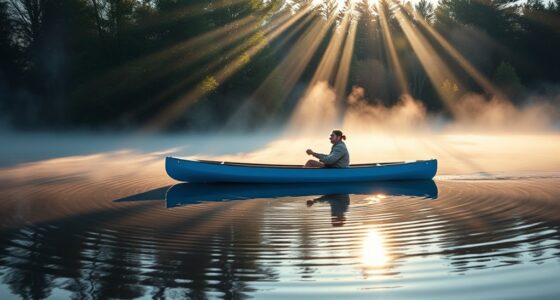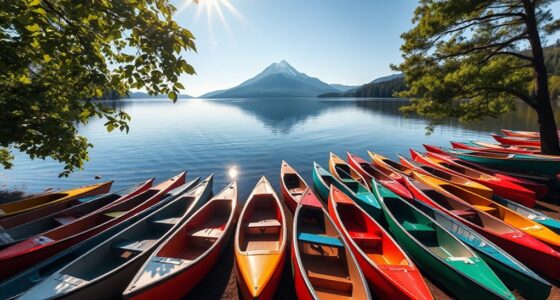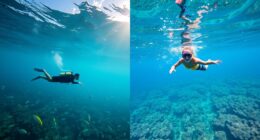To master the J-stroke for solo canoeing, start with a smooth forward stroke on the side you want to correct. Rotate your wrist gently to form a J-shape at the paddle’s end and push outward slightly back to counter veering. Engaging your core and keeping a relaxed posture help maintain control. Practicing these techniques will give you better control and straight-line paddling. Keep going, and you’ll release even more skills for confident solo adventures.
Key Takeaways
- Start with a smooth forward stroke on the turning side to initiate the J-stroke.
- Rotate your wrist gently at the end of the stroke to shape the J with the paddle blade.
- Push outward and slightly back to counteract veering and straighten your course.
- Engage core muscles and sit upright to improve paddle control and maintain a straight path.
- Practice consistently to develop muscle memory and refine your J-stroke technique for better accuracy.

Have you ever wondered what it’s like to glide silently across a calm lake all on your own? Solo canoeing offers that peaceful experience, but it also demands a good deal of skill—especially when it comes to maintaining straight lines. Mastering the J-stroke is essential, and it all starts with understanding your stability techniques and choosing the right paddling gear. When you’re paddling solo, your balance and control become your top priorities, so focusing on stability techniques helps you stay centered and confident on the water. Keep your weight centered in the canoe, leaning slightly forward to avoid tipped edges, and use your legs subtly to help stabilize your body. It’s a balancing act that improves with practice, but the key is staying relaxed and alert, so you can react quickly to any shifts in water currents or wind. Additionally, the use of stability techniques can significantly improve your confidence and control on the water.
Center your weight, stay relaxed, and use subtle leg movements to maintain stability while solo canoeing.
Selecting the proper paddling gear plays a vital role in executing smooth, straight strokes. A lightweight paddle with a comfortable grip allows for better control and reduces fatigue, especially during longer trips. Look for paddles made from durable, yet lightweight materials like carbon fiber or aluminum. A well-fitting PFD (personal flotation device) isn’t just a safety requirement; it also provides extra stability when you need to shift your weight or recover from an imbalance. Additionally, consider using a paddle leash or tether to prevent losing your paddle if you accidentally drop it. These small gear choices can make a big difference in maintaining your line and conserving energy.
When it comes to the actual paddling technique, the J-stroke is your best friend. It’s designed to correct the slight veer that can happen when paddling straight. To execute it properly, start with a smooth, powerful forward stroke on the side you intend to turn away from. As you reach the end of the stroke, gently rotate your wrist to form a J-shape with your paddle blade, then push outward and slightly back. This action counteracts the natural tendency of the canoe to veer off course, helping you stay on a straight path. Incorporate your stability techniques by sitting upright and engaging your core, which gives you more control over your paddle and the canoe’s direction.
The more you practice these stability techniques and refine your paddling gear choices, the more natural straight-line paddling will become. With patience and consistent effort, you’ll find yourself gliding effortlessly across the water, your strokes smooth and precise. Solo canoeing becomes not just a peaceful escape but a rewarding challenge, testing your skills and patience while offering the serenity of the open water.
Frequently Asked Questions
How Do Weather Conditions Affect Solo Canoeing and J-Stroke Effectiveness?
Weather conditions considerably impact your canoeing experience and the effectiveness of your J-stroke. Wind impact can push your canoe off course, making it harder to maintain a straight line. Water surface conditions, like choppy waves or calm water, also affect control. In rough conditions, you need to adjust your J-stroke to counteract drift. Being aware of these factors helps you stay on course and paddle efficiently under different weather scenarios.
What Gear Is Essential for Mastering J-Stroke in Solo Canoeing?
To master the J-stroke, you need essential gear like a comfortable paddle grip and proper canoe balance. Your paddle grip should be firm but relaxed, allowing smooth control. Focus on maintaining good canoe balance to stay steady while practicing your stroke. Investing in lightweight paddles and balance aids helps improve technique. With the right gear, you’ll develop better control, making your straight-line paddling more efficient and enjoyable.
How Can I Prevent Fatigue During Long Solo Canoe Trips?
Imagine your energy as a delicate flame; keep it burning bright by mastering hydration strategies and rest planning. Drink water consistently and avoid waiting until you’re thirsty. Balance your paddling with proper rest intervals, like giving your muscles a well-deserved vacation. Stretch and breathe deeply during breaks to recharge. These practices help prevent fatigue, ensuring your journey remains smooth and enjoyable, no matter how long the waterway calls.
Are There Specific Techniques for Maneuvering in Tight Spots?
When maneuvering in tight spots, focus on improving navigational precision and paddle control. Use small, deliberate strokes to steer accurately and avoid overcorrecting. Keep your paddle strokes smooth and controlled, adjusting your angle gradually. Practice reverse strokes and edging techniques to tighten turns. Staying relaxed and aware of your boat’s movement helps you navigate tricky spaces with confidence, making your paddling more efficient and enjoyable.
How Do I Recover From a Capsizing While Solo Canoeing?
When you find yourself in hot water after capsizing, remember that quick action is key. Use your capsize recovery techniques and self-rescue strategies to stay calm and regain control. Start by bailing water, then stabilize your canoe, and finally, re-enter from the stern or bow. Practice these steps regularly so they become second nature, helping you stay afloat and confident on the water.
Conclusion
Mastering the J-stroke is essential for staying on course when solo canoeing. With consistent practice, you’ll find it easier to navigate straight lines and enjoy smoother paddling. Did you know that skilled solo paddlers can improve their steering accuracy by up to 30% with proper J-stroke technique? Keep honing your skills, and you’ll not only paddle straighter but also boost your confidence on the water, making every trip more enjoyable and safe.










